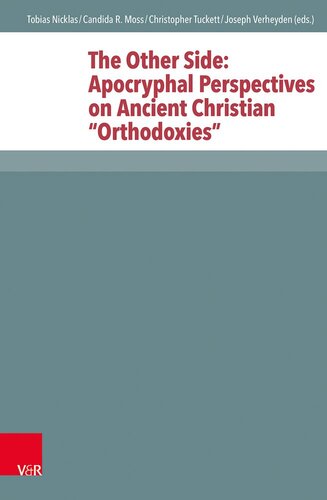(Ebook) The Other Side: Apocryphal Perspectives on Ancient Christian 'Orthodoxies' (Novum Testamentum Et Orbis Antiquus/Studien Zur Umwelt Des N) (Novum ... zur Umwelt des Neuen Testaments, 117) by Tobias Nicklas (editor), Candida R. Moss (editor), Christopher Tuckett (editor), Joseph Verheyden (editor) ISBN 9783525540589, 9783647540580, 3525540582, 3647540587
English summary: Anyone who wishes to manage their sources adequately must work with categories that help to bring order to the transcribed material. In many cases, such categories simultaneously shape the way in which we evaluate our sources. Critical reflection of the chosen categories is therefore crucial for robust historical study. This rings especially true when certain categories are not viewed through neutral eyes, but through polemically judgemental eyes. One extreme case would be the category of "apocryphalness". In some areas, associations like "fraudulent" versus and "secret" - interlinked to this term in Antiquity - are still shaping the way Christian apocrypha are considered to this day. Closely associated with this is the use of the adjectival categories like "(proto)-orthodox", "majority church" versus those like "heretical" (again polemically pejorative).In their chapters, the contributors demonstrate not only how the set limits - as referred to the categories above - do indeed play a role, but more importantly, where these limits have been exceeded and where we must therefore work with new and different categories to understand the meaning of "apocryphal" writings and/or writings that have "become apocryphal" in terms of the history of an ancient Christianity perceived as multi-dimensional and dynamic. The following questions play a significant role in our understanding of this: In which contexts and by which groups are "newly apocryphal" writings used? Where do apocryphal writings or those "newly apocryphal" play a contextual role that would, nowadays, be perceived as "orthodox"? Which functions are assign thereto? German description: Wer angemessen mit Quellen umgehen will, muss mit Kategorien arbeiten, welche helfen, Ordnung in das uberlieferte Material zu bringen. Gleichzeitig pragen solche Kategorien in vielen Fallen unsere Wertung von Quellen. Deswegen ist auch die kritische Reflexion der verwendeten Kategorien entscheidend fur verantwortliches historisches Arbeiten. Dies gilt besonders dann, wenn bestimmte Kategorien nicht neutral, sondern allzu haufig polemisch wertend verwendet werden. Ein extremer Fall ist die Verwendung der Kategorie "apokryph". Die sich bereits in der Antike mit dieser Bezeichnung verbindenden Assoziationen von "gefalscht" einerseits und "geheim" andererseits pragen in manchen Bereichen bis heute den Umgang mit "christlichen Apokryphen". Eng verbunden ist damit haufig die Verwendung der Kategorien "(proto-)orthodox", "mehrheitskirchlich" einerseits und (erneut polemisch abwertend) "haretisch" andererseits.In den Beitragen des vorliegenden Bandes wird gezeigt, wo Grenzen, die in den oben diskutierten Kategorien gesetzt werden, tatsachlich eine Rolle spielen, vor allem aber, wo diese Grenzen uberschritten sind und wir deswegen mit neuen, anderen Kategorien arbeiten mussen, um die Bedeutung "apokrypher" bzw. "apokryph gewordener" Schriften fur die Geschichte eines vieldimensional und dynamisch verstandenen antiken Christentums zu verstehen.Folgende Fragen spielen dabei eine entscheidende Rolle: In welchen Kontexten und durch welche Gruppen werden apokryph gewordene Schriften verwendet? Wo spielen apokryphe bzw. apokryph gewordene Texte in Kontexten eine Rolle, die wir heute als "orthodox" bezeichnen wurden? Welche Funktionen kommen ihnen dabei zu?
*Free conversion of into popular formats such as PDF, DOCX, DOC, AZW, EPUB, and MOBI after payment.


